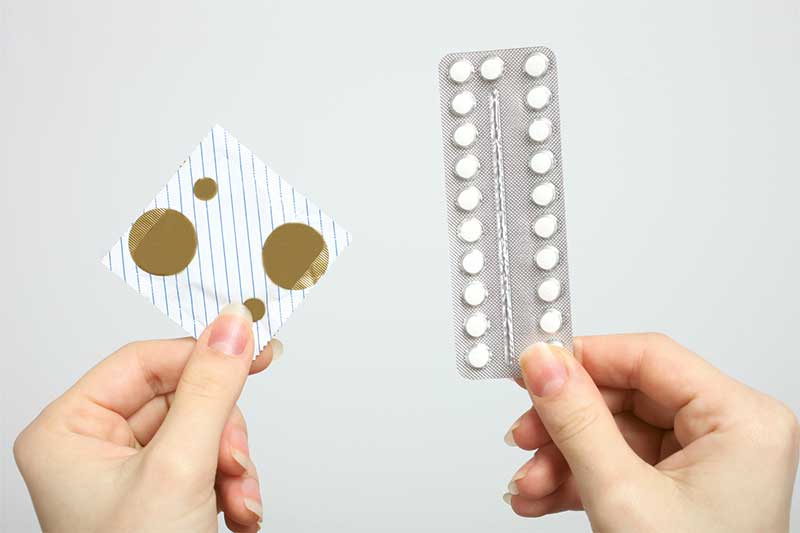Your Postpartum Contraceptive Options Explained

During your antenatal care, your LMC will guide you in choosing a contraceptive so you can make an informed decision about which option is best for you.
Deciding on contraception may be the furthest thing from your mind once you’ve had your baby but if you aren’t ready to get pregnant again or you don’t want to have any more children, it’s important to use an effective contraceptive method.
Here’s an overview of the most common forms available to you in the postpartum period. For more information on these methods listed, including risks and side effects, consult your LMC, GP or Family Planning.
CONTRACEPTIVE IMPLANT (JADELLE)
How it works
A small rod is inserted beneath the skin on the inside of your upper arm. It contains a hormone called progesterone that is slowly and continuously released into your body to inhibit the release of an egg each month.
When you can use it
It is generally advised not to have the implant inserted earlier than six weeks after birth.
Effectiveness
Over 99%.
Pros
- It can be used long term (up to five years).
- It is safe to use while breastfeeding.
- It can be removed at any time.
- Once it’s fitted, you can forget about it.
- You can get pregnant as soon as it is removed.
Cons
- Some people experience irregular bleeding, bleeding between periods, longer periods, spotting or no bleeding at all while on Jadelle.
- It provides no protection against STIs.
- It must only be inserted and removed by a doctor or healthcare professional who is trained to put in and take out implants.
- Occasionally, it may be sore to have it inserted or removed.
- It may not be an option for some people on certain medications.
DEPO PROVERA INJECTION
How it works
A contraceptive injection containing a hormone called progesterone that stops your ovaries from releasing an egg each month.
When you can use it
Breastfeeding people may be advised to have it administered from six weeks after birth.
Effectiveness
99% provided you have your injection on time, every 12 weeks.
Pros
-
It is safe to use while breastfeeding.
-
It lasts for 12 weeks.
-
It may be helpful for people who experience heavy periods.
Cons
-
Some people experience irregular or prolonged bleeding.
-
Some people experience weight changes – some put on weight, others lose weight but most do not change weight.
-
It provides no protection against STIs.
-
It may not be an option for some people on certain medications.
-
It may take up to one year for your fertility to return to normal after stopping the injections.
COPPER IUD
How it works
An intrauterine device (IUD) that contains copper which stops sperm from reaching the egg. If sperm does reach the egg, the device stops the egg from implanting in the uterus.
When you can use it
It is generally advised to have an IUD inserted from six weeks after birth.
Effectiveness
At least 99%.
Pros
-
It is safe to use while breastfeeding.
-
It can last up to five years.
-
Once it’s fitted, you can forget about it.
-
It can be removed at any time.
-
It does not contain any hormones.
-
You can get pregnant as soon as it is removed.
-
It can also be inserted and used as emergency contraception.
Cons
-
It provides no protection against STIs.
-
Some people experience heavier and prolonged bleeding in the first few months but this usually gets better with time.
CONDOMS
How it works
A fine barrier, usually made of latex or rubber, that is rolled onto the penis before sex to stop semen from entering the vagina.
When you can use it
They can be used at any time. If you need to use additional lubrication opt for a water or silicone-based one.
Effectiveness
Up to 98%, if used correctly. Typically, the rate is more like 85%.
Pros
-
They are affordable – you can get them on prescription from your doctor, a sexual health centre, or a Family Planning clinic.
-
They are easily accessible and easy to use.
-
There are no side effects (unless you are allergic to rubber or latex and in this instance your doctor can advise you on using special condoms).
-
Use of condoms reduces your risk of contracting STIs.
Cons
-
If the condom slips or breaks, you will need to use emergency contraception within 72 hours of having sex to prevent pregnancy.
HORMONAL (MIRENA) IUD
How it works
An intrauterine device (IUD) that contains a hormone called progesterone which thickens the mucus in the cervix to stop sperm from reaching the egg. If sperm does reach the egg, the device stops the egg from implanting in the uterus.
When you can use it
It is generally advised to have an IUD inserted from six weeks after birth.
Effectiveness
At least 99%.
Pros
-
It is safe to use while breastfeeding.
-
It can last up to five years.
-
Once it’s fitted, you can forget about it.
-
Some people have lighter or no periods.
-
It has a small amount of hormones so most people have no side effects.
-
It can be removed at any time.
-
You can get pregnant as soon as it is removed.
Cons
-
It provides no protection against STIs.
EMERGENCY CONTRACEPTIVE PILL (ECP)
How it works
A pill that contains a high dose of the hormone progesterone which works by delaying ovulation and changing the lining of your uterus to prevent a fertilised egg from implanting.
When you can use it
It can be used any time after birth and is best taken up to three days (72 hours) following sex – the sooner it is taken, the better.
Effectiveness
The World Health Organisation (WHO) indicates that it has a success rate of:
- 95% when taken within 24 hours of having sex.
- 85% when taken within 25-48 hours of having sex.
- 58% when taken within 49-72 hours of having sex.
Pros
-
It is safe to take while breastfeeding.
-
It is low-cost or free in some cases when prescribed by your GP or Family Planning.
-
It is available over-the-counter at pharmacies.
-
It should not be used as a regular method of contraception because it is not as effective as other methods.
Cons
-
Some people feel nauseous after taking it – it’s best to have it with food.
-
If you vomit within three hours of taking the ECP, you’ll need to take another pill.
-
It is less effective for people who weigh more than 70kg. In this instance, an emergency copper IUD may be a better option.
-
It provides no protection against STIs.
PROGESTERONE-ONLY (MINI) PILL
How it works
A pill that you take at the same time every day which only contains the hormone progesterone. This method works by thickening the mucus in the cervix to stop sperm from reaching the egg. It also alters the lining of the uterus to prevent a fertilised egg from implanting.
When you can use it
Breastfeeding people may be advised to start the mini pill from six weeks after birth.
Effectiveness
It is 96-99% effective when taken correctly.
Pros
-
It is safe to take while breastfeeding.
-
It is simple to use.
-
It doesn’t interfere with sex.
-
A good option for people who can’t take the combined oral contraceptive pill.
-
There are very few side effects.
Cons
-
It is important to take the pill at or as close to the same time every day or it will not be as effective.
-
It provides no protection against STIs.
-
Some people experience irregular periods or no periods.
-
If you have missed a pill and not used additional contraception, you will need to use emergency contraception within 72 hours of having sex to prevent pregnancy.
COMBINED ORAL CONTRACEPTIVE PILL
How it works
A pill that you take every day which contains two hormones, oestrogen and progesterone that stop your ovaries from releasing an egg each month.
When you can use it
It is not recommended for people who are breastfeeding. People who aren’t breastfeeding can start taking the pill 21 days after birth.
Effectiveness
It can be up to 99% effective if taken correctly, but the standard rate is around 92%.
Pros
-
It is easy to use.
-
It doesn’t interfere with sex.
-
Some people find that it improves their acne and lightens their periods.
-
You can skip your period by missing the non-hormonal pills and taking the hormonal pills continuously.
-
You can get pregnant as soon as you stop taking it continuously.
Cons
-
If you forget two or more pills in a week, you will not be protected from pregnancy.
-
It is not recommended for people who are breastfeeding as it may decrease your milk supply.
-
You have to take it every day – it’s best to take it at the same time.
-
Some people experience irregular bleeding or spotting within the first couple of months.
-
It provides no protection against STIs.



